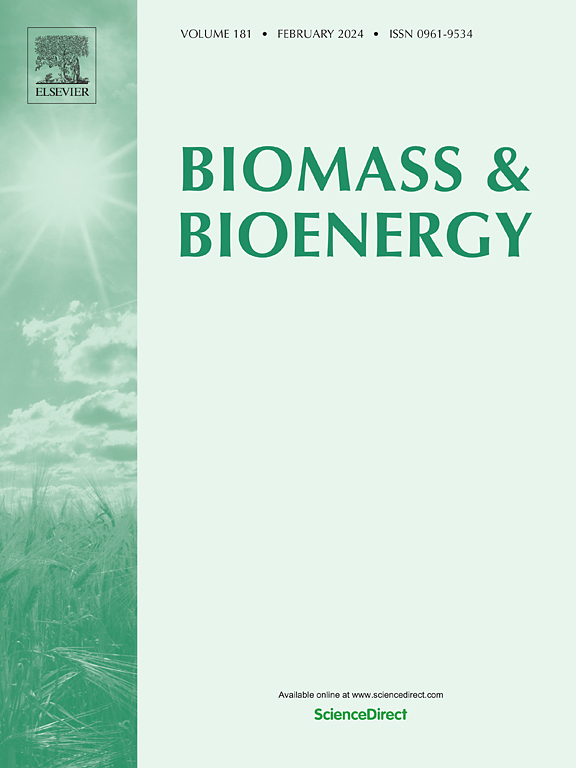通过铜基镁-氧化铝层状双氢氧化物材料进行生物质衍生糠醛加氢
IF 5.8
2区 生物学
Q1 AGRICULTURAL ENGINEERING
引用次数: 0
摘要
糠醛是一种重要的平台化学品和致癌衍生物;因此,必须加以利用,将其转化为增值产品。采用铜基镁铝催化剂,研究了糠醛气相加氢制糠醇的工艺。在此,我们通过多种光谱和分析技术来研究合成的催化剂,以确定所开发的材料的理化性质。523 K时催化剂的还原得到了糠醛有效加氢反应的最有效催化活性位点,其中铜在镁-氧化铝载体上的不同比例对糠醇具有较高的选择性。温度研究表明,25CMA催化剂在453 K时表现最佳,产率为64.5%,但在较高温度下,催化剂逐渐失活。催化剂表现出近30小时的稳定性,随后活性逐渐下降,这可能是由于焦炭的形成,并从TGA和BET分析中得到了验证。通过H2-TPR分析,提出了合理的反应机理,认为糠醛转化为糠醇的主要因素是Cu0的生成。25CMA催化剂的长期稳定性和持续的催化活性为该催化剂在糠醛加氢制糠醇的工业应用铺平了道路。本文章由计算机程序翻译,如有差异,请以英文原文为准。

Biomass-derived furfural hydrogenation via copper-based magnesia-alumina layered double hydroxide-like material
Furfural is a vital platform chemical and a carcinogenic derivative; therefore, it must be utilized and converted into a value-added product. The vapor-phase hydrogenation of furfural to yield furfuryl alcohol is studied via a copper-based magnesia-alumina catalyst. Herein, we have investigated the synthesized catalysts by several spectroscopic and analytical techniques to determine the physiochemical properties of the developed materials. The reduction of catalyst at 523 K gave the most catalytically active sites for the effective hydrogenation of furfural wherein the varied ratio of copper on magnesia-alumina support showed higher selectivity towards the furfuryl alcohol. The temperature study depicted that the 25CMA catalyst performed best at 453 K with a yield of 64.5 %, but at higher temperatures, it gradually deactivates the catalyst. The catalyst showed stability of almost 30 h, and further, a gradual decrease in the activity was observed, which could be attributed to the coke formation and validated from the TGA and BET analysis. The plausible reaction mechanism was proposed based on H2-TPR analysis, which suggested the formation of Cu0, which was a major factor in the conversion of furfural to furfuryl alcohol. The long-term stability with sustained catalytic activity for the 25CMA catalyst paves the way for the catalyst's industrial applicability for the furfural hydrogenation to yield furfuryl alcohol.
求助全文
通过发布文献求助,成功后即可免费获取论文全文。
去求助
来源期刊

Biomass & Bioenergy
工程技术-能源与燃料
CiteScore
11.50
自引率
3.30%
发文量
258
审稿时长
60 days
期刊介绍:
Biomass & Bioenergy is an international journal publishing original research papers and short communications, review articles and case studies on biological resources, chemical and biological processes, and biomass products for new renewable sources of energy and materials.
The scope of the journal extends to the environmental, management and economic aspects of biomass and bioenergy.
Key areas covered by the journal:
• Biomass: sources, energy crop production processes, genetic improvements, composition. Please note that research on these biomass subjects must be linked directly to bioenergy generation.
• Biological Residues: residues/rests from agricultural production, forestry and plantations (palm, sugar etc), processing industries, and municipal sources (MSW). Papers on the use of biomass residues through innovative processes/technological novelty and/or consideration of feedstock/system sustainability (or unsustainability) are welcomed. However waste treatment processes and pollution control or mitigation which are only tangentially related to bioenergy are not in the scope of the journal, as they are more suited to publications in the environmental arena. Papers that describe conventional waste streams (ie well described in existing literature) that do not empirically address ''new'' added value from the process are not suitable for submission to the journal.
• Bioenergy Processes: fermentations, thermochemical conversions, liquid and gaseous fuels, and petrochemical substitutes
• Bioenergy Utilization: direct combustion, gasification, electricity production, chemical processes, and by-product remediation
• Biomass and the Environment: carbon cycle, the net energy efficiency of bioenergy systems, assessment of sustainability, and biodiversity issues.
 求助内容:
求助内容: 应助结果提醒方式:
应助结果提醒方式:


